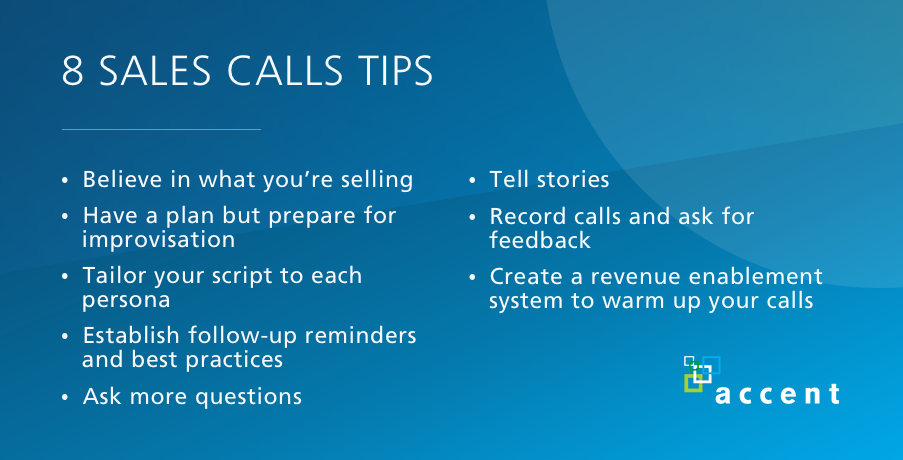sales
Sales Calls Tips
Optimize your sales calls with these data-backed tips from experienced experts
The time-tested relevance of the sales call
Selling over the phone is a discipline that’s been around since well before the internet. It has sustained and grown many businesses.

Tip #1: Believe in What You’re Selling
Voice inflections and emotional tone have a powerful effect on persuasion. One of the greatest benefits of selling over the phone is that these are tools at the sales reps disposal.
And if there’s one thing that prospects can see right through, it’s a sales rep that doesn’t believe in what they’re selling.
If your reps don’t believe that whatever they’re selling can affect positive change in a prospect’s life, how can you expect anyone to buy?
Your reps need to be confident and excited about the value of your offering. Note that excited doesn’t mean hyperactive, loud, or boisterous. Nor does it mean enthusiastic about the product for the product’s sake. It means being energetically optimistic about the product’s ability to solve a prospect’s problem.
So how do you get your reps to this point? Plain and simple, they need to understand prospect pain points better than the prospects themselves do. Secondly, they need to understand exactly how the product meets and solves those very pains in meticulous detail.
This may mean listening to recorded sales calls of seasoned reps or speaking with the development or product team to better understand the product’s value.
Sales professionals tend not to be sheepish about what they believe in (I can see sales leaders nodding their heads right now). Likewise, it’s exceedingly obvious when they don’t believe in something.
Those micro-expressions and inflections are surefire tells on a phone call with a prospect.
Plus, nobody wants to spend their working life advocating for something they don’t believe in. That sounds like a lose-lose-lose; the prospect isn’t passionate, the company doesn’t profit, and the prospect isn’t helped.
Get your reps excited about the potential your product or service has to help prospects. If they can’t get excited, it’s likely your product (or their position) isn’t a good fit.
Tip #2: Have a Plan but Prepare for Improvisation
One of the staples of jazz music is improvisation. If you’re ever called to play a jazz standard at a jam session (an occurrence I’m sure many of our readers experience regularly), you’re expected to know the song’s overall structure, but also add new and creative flourishes to the composition.
This is a great analogy for sales calls. Having a plan and a loose script is essential. Otherwise, you risk rambling, missing important information, or sounding uninformed to your prospect.
Here’s a helpful template I used when I worked as an inside sales rep for a tech company:
- Confirm you’re speaking with the correct prospect
- Announce your name and the company you represent
- Articulate why you’re calling (you downloaded our eBook, you expressed interest in a demo, we met you at a conference, etc.)
- Ask them permission to ask a few questions about their pain points and how your solution can help
Ideally, they agree to the conversation, and you begin asking questions to uncover their core pain points. This helps you better understand how your solution can alleviate those pains (something we’ll dive deeper into later in this post).
From here, much of the conversation is improvisation. Your prospect’s questions may take you in a completely different direction than you originally planned. Or, you may find that the prospect isn’t a qualified lead at all and is looking for solutions your product can’t supply.
The point is to not have an “all-or-nothing” approach of a totally scripted plan or complete improvisation. The reality is somewhere in the middle.
Tip #3: Tailor your script to each persona
As your organization and sales teams grow, you’ll likely start to notice and develop personas or “avatars” for your ideal customers.
Sometimes, this happens organically as your product naturally attracts a certain demographic. Other times, persona development is a very intentional exercise for sales and marketing teams.
The point is that you’ll likely have three to five different “types” of people you’re selling to. The distinguishing features might be their position within the company, their decision-making power, or even their industry if you operate in multiple verticals.
Each script should be tailored to the pain points of whomever you’re speaking with. For example, if you sell software that helps with corporate compliance, your two main personas might be the IT manager and the HR manager.
Each of these persons has extremely different pain points and ideas of success within their role. They probably have radically different personalities, as well.
This means tailoring your script, your unique selling proposition (USP), even your tone and inflection to match your ideal prospect.
Smart reps will have “swipe files,” or documented scripts that pertain to each persona. This way, when it comes down to smile and dial, they can pull up the appropriate script for whomever they’re targeting.
The growth-minded among you may be asking the question: “Which person is the best to target?” In other words, one of your target personas will inevitably convert at a higher rate than the others. So how do you avoid spinning your wheels and calling folks who have no decision-making power?
We built the Sales Room feature inside of our Supercharger CRM to solve this very problem. The Sales Room is an intelligent visualization of who your reps have contacted within a particular account. Using AI technology and historical sales data, Supercharger makes prescriptive suggestions on which persona is most likely to result in a conversion.
This takes hours and hours of guesswork out of who to call and how to move a deal forward.
Tip #4: Establish follow-up reminders and best practices
I hate being a pest. Pestering prospects or coming off as needy was one of my biggest fears as a brand new inside sales rep. I thought that if people really wanted the solution I was offering, they would answer on the first ring and immediately hand over their hard-earned cash.
That’s simply not the reality.
People are busy. Very busy. Inboxes get full, voicemails get ignored, and messages get thrown away. This is why following up is such a crucial skill for sales reps.
There are three main reasons sales reps should follow up with a prospect after an initial phone call. Each of them needs to be handled differently:
The prospect agrees to a demo or next action step in the sales process
The prospect does not answer and no contact is made
The prospect offers a “maybe” (the absolute worst one)
Obviously, the way you handle number one is going to look much different than number two. However, the urgency and importance of following up don’t change. Sales reps must never consider a deal a “sure thing” until the prospect signs on the line that is dotted.
There’s a wide spectrum of opinions on how often sales reps should follow up with subsequent phone calls. But there’s a common sentiment amount all experienced sellers that sales reps should follow up.
A common-sense approach that’s worked for many businesses is following up in these increments:
- Two days from initial call
- Five days from initial call
- Two weeks from initial call
- One month from initial call
- Two months from initial call
- Six months from initial call
With every subsequent attempt, the interval of time grows larger. This accomplishes a few things:
- You’re less likely to annoy prospects with repeat calls
- You cover a wider area of time in case the prospect is out of the office or on vacation
- Your follow-ups have a broader time horizon which account for changing prospect needs (for example, your prospect may not have needed your solution today, but six months from now they will)
So, let’s say you make contact on follow-up number three (two weeks from the initial call). However, the prospect ghosts after that. What happens then? Well, the cycle starts all over again. You start from one and move all the way to five until you either make contact or the prospect is disqualified.
Maybe you completely disagree with the above template, and you believe following up on a daily basis is the right way to go. Sure, you’ll probably qualify or disqualify a prospect more quickly, but consider how many cycles of time your reps will burn to make those repeat calls.
Would you rather them focus on new business, or chasing after ghosted prospects? Maybe the answer is the latter for your business. Again, this isn’t settled science. This gentleman received an investment from a billionaire after following up 48 times.
If you don’t know where to start, implement the above template and tweak your strategy from there. Get buy-in from your sales team, set up automatic reminders in your CRM, and make decisions based on your industry data, not what everyone else is doing.
Tip #5: Ask more questions
We’ve probably all been in a one-sided conversation with a friend or family member. You know, those conversations where it feels like the person is talking “at you” and not “with you”? Maybe they monologue the entire time and don’t ask you a single question.
If you’re anything like me, this is the most mentally draining scenario imaginable. The same is true on sales calls.
When you make contact with a prospect only to endlessly rattle on about product features and technology, you not only fatigue them but potentially miss the mark on their actual problems.
Erring on the side of asking way more questions than giving answers is something any experienced sales rep will swear by. Asking great questions has so many utilitarian benefits to the phone seller.
Asking questions puts the ball in their court
Anytime you can get a prospect talking about their pain points or their work life, you’re collecting valuable data. This is demographic data that some companies are willing to pay a small fortune for, and this person on the other line is freely offering it to you.
These insights can challenge your preconceived notions of a prospect’s pain points, and likewise, help you pivot the conversation to best address them.
Asking questions helps them verbalize their pain
Sometimes, as busy worker bees, we don’t take time to pop our heads up for a 30,000-foot view of our career path or daily workflow. Asking questions of prospects — specifically, questions designed to uncover a particular pain point — can sometimes help those folks feel the “pinch” of a pain point they’ve learned to accept.
Here’s an example: let’s say you sell software that’s designed to streamline how sales reps manage and turn in their expense reports. You might ask questions like:
- “How many hours per week, on average, do you spend on expense reporting?”
- “What would be possible for you if you could get that time back?”
The prospect might respond, “I’d say I spend about three hours a week on expense reporting. If I had that time back, I could probably close two to three more deals per week.”
Do you see the power of asking questions? The prospect has just actualized his or her own pain point (perhaps for the first time ever). The gears will undoubtedly begin turning in their heads when they understand what’s at stake.
Who wouldn’t want to give up clerical work to close more deals and make more money?
And the best part? They were the ones who materialized this pain, not you. This makes it all the more impactful.
Tip #6: Tell Stories
There have been several neurological studies done that show how humans respond to stories. The conclusions, though slightly different in each study, echo a consistent refrain: we love stories. Scientifically, anecdotally, and in just about every situation, humans’ brains are more thoroughly engaged by stories.
One reason this is true is because of the release of oxytocin, a chemical in the brain that signals safety, comfort, and approachability in the presence of other humans.
In other words, not only are stories more interesting, but stories are scientifically proven to make people feel safer around the person telling the story. This certainly sounds like an ideal situation for a sales call, doesn’t it?
That’s why it’s essential for sales reps to be storing up — either informally or formally in a document — user success stories. These are people who have had pain points that mirror your prospect’s, who’ve adopted your solution and thus experienced positive change in their working lives.
Whenever you’re tempted to do a data dump of facts, features, or information, tell a story instead. Maybe it’s as simple as, “I’ve worked with someone who struggled with that before. That sounds really rough.” Or as robust as a full-on case study.
Either way, when you do talk (remember tip #5), do your best to put a narrative spin on what you’re saying. Stories have a way of making dry material interesting, and also activate the empathy centers of the brain.
This helps the prospect not only trust your solution more, but imagine themselves in the shoes of the protagonist (and all the benefits your solution affords them).
Tip #7: Record calls and ask for feedback
I worked for a boss who was fond of saying he specialized in R&D: “robbing and duplication.” His tongue-and-cheek adage was a nod to the power of best practices. This is especially true in sales.
You can’t improve what you can’t measure.
If one of your fellow reps are absolutely killing it on their sales calls, wouldn’t you want to be a fly on the wall? Wouldn’t you want a little insight into their technique? This is where recording calls comes into play.
And the easiest way to measure and improve your sales call technique is to record it and share it with a trusted group of professionals for honest feedback. It might sting a little at first to hear your every word scrutinized and critiqued, but if you’re willing to swallow your pride, it can pay dividends.
One of the benefits of the Accent’s Sales AI platform is that it automatically tracks all customer communications, including transcribing phone calls. This way, sharing best practices and critiquing sales calls with pinpoint accuracy is simple and automated.
Tip #8: Create a revenue enablement system to warm up your calls
Nobody likes making cold calls and nobody likes receiving cold calls. Anything you can do to warm up a prospect, either to qualify them for your solution or increase the likelihood of a profitable conversation, is wise.
Thankfully, there is a bevy of sales enablement tools to help you maximize your sales calls. Whether it’s warming up a prospect with great sales enablement content, scoring them based on their web activity, or managing automated follow-ups, there’s a lot you can do to make sales calls smoother.
This is pointing to a bigger reality: sales calls alone won’t sustain growth and profitability, but as part of a holistic “revenue enablement” strategy, they’re an irreplaceable weapon in your arsenal.
The Accent Technologies suite of software exists to maximize revenue and eliminate ineffective sales calls. Our cloud-based revenue enablement platform empowers your reps to conduct their sales calls with greater confidence and data-backed insights on their prospects’ pain points.
For more information on how Accent can help you optimize your sales calls (and your entire sales strategy), contact our team today.
By Accent Technologies
3rd November 2020
Sales Calls Tips the Accent Way
Executing effective persona-targeted messaging, sales plays, and follow ups can be extremely difficult in a complex B2B sales situation. Especially, if you’re basing your game plan on subjective assumptions about the opportunity’s health, intent, and key influencers.
But what if you could KNOW for certain who you’re engaged personas are? What if you could confirm their level of influence on the purchasing decision, and see how they reacted to each activity your sellers conduct with them?
With that level of insight, you could build an iron-clad sales effectiveness analysis, and dramatically improve execution of your sales team.











